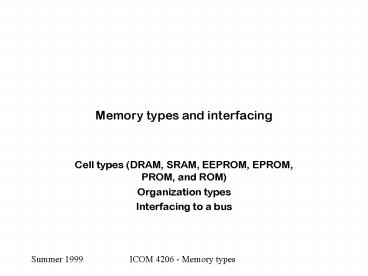Memory types and interfacing - PowerPoint PPT Presentation
1 / 10
Title:
Memory types and interfacing
Description:
Summer 1999. ICOM 4206 - Memory types. Memory types and interfacing ... This data is from PC Hardware in a Nutshell, Thompson & Thompson, O'Reilly, 2000 ... – PowerPoint PPT presentation
Number of Views:101
Avg rating:3.0/5.0
Title: Memory types and interfacing
1
Memory types and interfacing
- Cell types (DRAM, SRAM, EEPROM, EPROM, PROM, and
ROM) - Organization types
- Interfacing to a bus
2
Memory - from the cell up
- Cell types - in decreasing order of forgetfulness
- DRAM - Dynamic RAM - remembers for 4ms or so
- SRAM - Static RAM - remembers while the power is
on - EEPROM - Static RAM that remembers even with
power off - EPROM - Electrically programmable ROM
- UVPROM - Electrically programmable - UV erasable
ROM - PROM - Programmable, just once
- ROM - Factory programmed ROM
- Organization types
- All are more-or-less square arrays of cells with
addressing and read/write logic - Field programmables usually require an extra,
higher programming voltage
3
Cells
Data In
Y Select
- Basic Cell
- Selected by X and Y
- Outputs data when selected
- DRAM loses info when read
- SRAM, etc., retain info
- Cell array
- More-or-less square array of cells
- Select logic
- Maps N address lines into 2-nth select lines
- Data logic
- Not shown
- Sends data to/from selected cell
X Select
Basic Cell
Data Out
Address lines
Y select logic
X sel ect
Rectangular array of cells
4
Memory organization and readoutAll nondynamic
types
- Example, 2K x 8 memory
- 11 address lines
- 8 data lines
- Read/Write
- Chip select
- Power
- 16K - 2 to 14th cells
- 128 x 128 array
5
Memory organization and readoutAll dynamic types
- Example, 1M x 4 memory
- 1M (220) address space
- 20 address lines (time-shared between row and
column) - 4 data lines
- Read/Write
- Row address strobe (RAS)
- column address strobe (CAS)
- Chip select
- Power
- 4M - (222) cells
- 256 x 256 x 4 array
6
Memory cycle dynamic RAM
- Steps in a read cycle
- Lower bits of address (row address) asserted,
then edge-triggered in by RAS - Entire row is transferred (destructively) to row
buffer - Upper bits of address (row address) asserted,
then edge-triggered in by CAS - Selected 4 bits are gated to output pins
- Entire row buffer is transferred back to memory
cells of row - Steps in a refresh cycle
- Lower bits of address (row address) asserted,
then edge-triggered in by RAS - Entire row is transferred (destructively) to row
buffer - Entire row buffer is transferred back to memory
cells of row
7
More memory cycles dynamic RAM
- Steps in a write cycle (late write)
- Lower bits of address (row address) asserted,
then edge-triggered in by RAS - Entire row is transferred (destructively) to row
buffer - Upper bits of address (row address) asserted,
then edge-triggered in by CAS - Selected 4 bits of data are gated to selected
bits of row buffer - Entire row buffer is transferred back to memory
cells of row - Read-modify-write
- Data is read, new data is written
- Early write
- Data is transferred along with strobes rather
than waiting for row transfer, then gated into
row buffer
8
Memory addressing details
- Wide-bus issues
- Example MIPS
- Memory is basically word-organized
- This means bottom two bytes of address bus are
always 0 for a full-word operation - Specialized write cycles
- Single-byte (byte 0, 1, 2, or 3)
- Left end (1,2, or 3 bytes)
- Right end (1,2, or 3 bytes)
- For these transfers data normally emerges from
CPU on the correct lines for the byte - Wide-bus, narrow memory or device
- Example byte- or halfword-oriented interface on
word-wide bus - Data must emerge on low-order bytes of bus not
like odd-byte read of memory - This logic is normally part of the I/O bus
structure odd addresses in byte-wide bus cause
data to be copied to/from low-order bytes
9
Memory addressing details
- Alternatives to the logic
- I/O register numbers are multiples of 2 or 4
- This means register selects are connected to bits
2 to x of address bus - Common for memory-mapped interfaces
- Slow transfers
- CPU can do NOPs while transfer occurs
- Device or bus logic can request wait states
- Often done by operating system HLL outb, inw,
etc. system calls take care of this
10
Memory types in newer PCs
- DRAM
- Asynchronous
- Clock cycle is of fixed minimum duration slow
transfer wastes an entire clock cycle - This category includes EDO (extended data output)
pre-1999 - Synchronous (usually called SDRAM)
- Shares clock with CPU CPU doesnt have to wait
for next memory time slot - DDR-SDRAM two transfers per clock cycle
- Protocol-based uses specialized bus (narrow,
high-speed) for higher speeds (200 MHz) - Parity and ECC (error-correcting code)
- Parity is obsolescent
- ECC is often used on servers
- Packaging
- Most now use DIMMs (168-pin is 64 bits wide,
72-pin is 32)
This data is from PC Hardware in a Nutshell,
Thompson Thompson, OReilly, 2000































